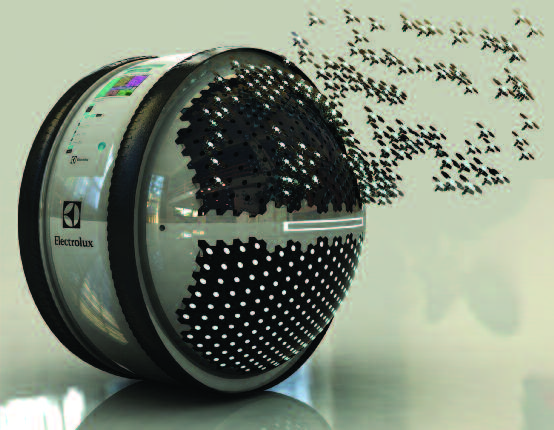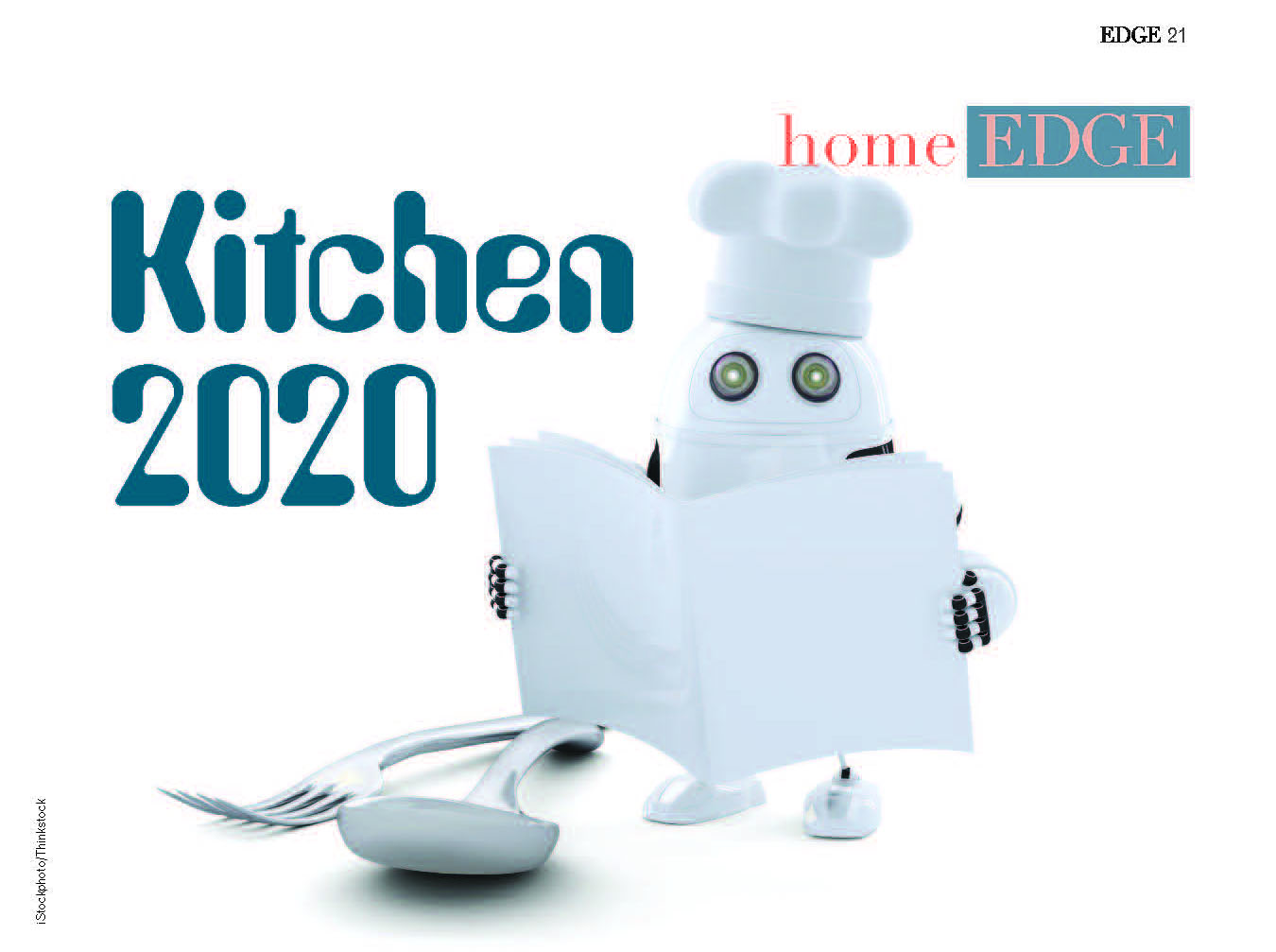Relax…let your nano-robots do the dishes
Speckled linoleum. Avocado appliances. Fluorescent lighting. These design tragedies are a distant memory compared to the contemporary kitchens of the 21st century. There’s no doubt about it: We’ve come a long way, baby. Yet, by 2020, the kitchen we are so proud of today may be just as outdated, antiquated and embarrassingly obsolete. And although the word kitchen will never entirely disappear from our vocabulary, it’s possible that we may be grasping for a new name that describes a room that plays a much more expanded role in our domestic surroundings.

Photos courtesy of Michael Harboun
If you have redone your kitchen in the past decade, you may be in for a rude awakening when the 2020’s hit. The state-of-the-art hallmarks that we so proudly (not to mention, expensively) included in our dream kitchens will seem like art only in the sense that some will belong in a museum. Indeed, the kitchen of the not-too-distant future will embrace science and technology as well as aesthetics.

Whirlpool already began previewing its Kitchen of 2020 at the recent Consumer Electronics Show (CES) in Las Vegas. One item in particular had kitchen remodelers dancing in the aisles: a refrigerator that will be Bluetooth-enabled to stream music into your kitchen. You will be able to coordinate your menu to an appropriate musical background at a tap of a finger. If it’s salsa your prepping, then salsa can be your music of choice. If it’s an elegant and high-end Beef Wellington, then something classical may be in order. Downhome spread? How about some Brad Paisley? No need to drag that iPod or iPad into your work area. That’s so 2013.
One day, by the way, your refrigerator may not even have a door—at least as we know it today. Instead, you’ll be able to push and pull your food through a see-through gel-like framework (hopefully tinted to coordinate with your color scheme). If you think this sounds like something out of a Jetsons cartoon, think again. To retrieve an item from the Bio Robot Fridge, all you will have to do is reach through an odorless, non-sticky polymer gel and pull it out. No more leaving that refrigerator door open or endlessly wiping off greasy little fingerprints. Russian student Yuriy Dmitriev took second place at the Electrolux Design Lab competition with this idea. Four years ago.
HOT TOPIC
One cannot discuss the Kitchen of 2020 without addressing its very essence, the stove. From huge cauldron-bearing hearths to black and bulky cast iron relics to built-in multi-burner tops, the kitchen remains first and foremost a place to cook. The word kitchen actually comes from the Old Latin word coquere, meaning “to cook”—which evolved into the Old English Cycene, to kichene in Middle English, to cucina in Europe, and eventually to our word. At its CES exhibit, another Whirlpool highlight was an induction cooktop designed to turn your countertop into a stove. Four dozen micro-inductors create one large cooking surface on which you can position up to four pots and pans. Since the heat is produced only where needed, the rest of the top stays cool to the touch. By the time this technology hits the market, there won’t be any control knobs; you’ll just tell the stove what you want it to do. Voice recognition technology will almost certainly be available on most appliances in 2020 and—perhaps more intriguingly—appliances may be talking back. Think about that for a second.
A go-green sensibility will also be part of new kitchens in 2020. Eco-clean, eco-friendly and eco-smart features will be available in almost every aspect of kitchen design. We might be looking at recycling sinks that hygienically reuse the same water supply, as well as more advanced versions of products that are already hitting the market: Nutrima (a foldable appliance to calculate nutritional values, possible toxins and food freshness), the Kitchen Hub (a food inventory and expiration monitor), the GE Advanced Filtration System (which removes 98% of important trace pharmaceuticals), and the LG Blast Chiller (five minutes to chill a can and eight for a bottle of wine).
Glass will almost certainly play an expanded role in the Kitchen of 2020. It is already becoming a popular design choice, replacing ceramic tiles above counters, sinks and stoves. However, in the next decade, we will begin to see glass used as part of energy solutions and not just aesthetics. There are plans afoot to use this material in roof and wall components that will funnel the power of the sun into kitchen appliances. We could also see glass-enclosed “living” walls that produce herbal greenery and edible fish and sea vegetation. The goal? To make the kitchen of the future a standalone, self-sufficient space that will reflect sustainability above all else.
GREAT EXPECTATIONS
When envisioning the Kitchen of 2020, one of the greatest challenges is separating fantasy from reality. It’s one thing to brainstorm and another to pick the brains of people in the know. Two individuals with hands-on knowledge of what’s actually waiting in the wings are Maria Stapperfenne and Brian Pagel. Stapperfenne is a Certified Kitchen and Bath Designer, President-Elect of the National Kitchen & Bath Association, and a Manager at Tewksbury Kitchens & Baths. Pagel, a VP of the Kitchen and Bath Group for Emerald Expositions—one of North America’s largest trade show producers—gets the ultimate sneak peak of future products as he works with exhibitors to showcase their most innovative kitchen components.
Stapperfenne shared what she learned on her recent travels to expos in Las Vegas, Los Angeles and Milan. She saw, up-close and personal, some technological “super products” and design concepts that may not be available by 2020, but which are certainly in the pipeline. Her enthusiasm for what’s to come is infectious (see page 26). At Eurocucina in Milan in April, she was allowed to photograph one of the aforementioned induction-type cooking spaces that has been seamlessly integrated into a countertop. Understandably, makers of advanced technologies can get touchy about photos; this was the exception that proved the rule.
According to Stapperfenne, most major kitchen renovations are being undertaken by people in the 30-to-50 age range. These clients often save up for years for a new kitchen, so naturally they expect their investment to last 20 years. Given the increasing speed of technological advances, the actual “lifespan” may be much more compressed. Which can make for some nervous customers. Consequently, Stapperfenne describes her professional mission as “educating our clients to make intelligent and informed decisions, and then to have confidence in their choices.”
Cost is another issue. According to Stapperfenne, a kitchen remodel is a reflection of individual budgeting. She found an exhibitor at the Milan show who indicated that the level of investment for his displayed 18’ x 20’ kitchen was somewhere between $495,000 and$500,000! When asked what she would want most in her own future kitchen design, Stapperfenne put comfort and convenience at the top of her list.
Brian Pagel feels that, despite all the technological advances, the Kitchen of 2020 will still reflect many of today’s design touchpoints—in other words, what’s in now won’t necessarily be out by then. However, for longer-range predictions, he believes emphasis will be placed on accessible living, aging in place and the “totally wired” kitchen, with technology as integrated as in the rest of the house. Pagel also predicts that manufacturing will focus on reclaimed, reused and eco-friendly materials, along with energy efficiency. His most recent exposition in Las Vegas, the 2014 Kitchen & Bath Industry Show, was a joint venture with the National Association of Home Builders. This co-sharing opportunity reflects his conviction that close collaboration between construction and design—with the added advances in technology—represents the future not just for the kitchen, but for the entire home.
ALWAYS A GATHERING PLACE
With all its cutting-edge electronic enhancements and techno-friendly gadgets, tomorrow’s smart kitchen will remain the hands-down favorite gathering space—where “gathering” is the operative word. Granted, a kitchen may no longer be defined by any distinct perimeters, and will almost certainly migrate into other functional areas of the home. However, as the designated area for food-focused activity, high-tech efficiency and social interaction, it will remain the heart and soul of our homes in 2020 and for generations to come.
 2020 & BEYOND
2020 & BEYOND
When Maria Stapperfenne looks into her crystal ball, this is what she sees…
Wireless Power
We will power up our kitchens as easily as we access our Wi-Fi connections elsewhere in the house today. Countertops will be equipped with conveniences like Duracell’s PowerMat, a built-in charging pad that makes plugs obsolete, and we’ll get wireless delivery of our morning newspaper simply by tapping on the counter surface.
Lower Maintenance
People generally don’t like to clean, so the trend in kitchens is to modern styling with less ornamentation and flowery crevices in which to catch dirt. Modern and minimalism go together.
Transiency
One day, you may be able to change the look of your kitchen as easily as you change your wardrobe. Kitchen cabinetry and appliances will no longer be permanently installed, but instead will be wall-hung for easy removal to minimize the labor and upheaval associated with kitchen remodeling.
Voice Recognition
With a simple code word, you will be able to turn on your lights, start your oven, or order your favorite latte.
Personalization, Organization and Accessibility
Cabinet shelves and drawers can be personally outfitted, right down to contour-specific routing and grooving as cradles for your personal cutlery and dishware. Another exhibit at the Milan exposition featured a center island complete with a built-in storage unit that rises from the counter via remote control for quick access, much like today’s lift cabinets that hide large flat-screen TVs.
 So what else will be in your kitchen in 2020 and beyond? Interactive cookbooks and recipes should be available on pop-up or drop-down video screens, or through tablets and other devices connected to your kitchen’s “brain.” There are folks looking at creating smart countertops with bio scanners that can assess your nutritional needs. Your fridge will keep track of what you’ve got, what you need, and what’s about to go bad—and connect with your smartphone when you’re at the grocery store. The most-used source of heat in your kitchen? It could very well be steam. And that smart countertop may include built-in extractors to transform the steam to water for other general uses after it flows through the heating element. Nothing wasted; everything gained.
So what else will be in your kitchen in 2020 and beyond? Interactive cookbooks and recipes should be available on pop-up or drop-down video screens, or through tablets and other devices connected to your kitchen’s “brain.” There are folks looking at creating smart countertops with bio scanners that can assess your nutritional needs. Your fridge will keep track of what you’ve got, what you need, and what’s about to go bad—and connect with your smartphone when you’re at the grocery store. The most-used source of heat in your kitchen? It could very well be steam. And that smart countertop may include built-in extractors to transform the steam to water for other general uses after it flows through the heating element. Nothing wasted; everything gained.
Speaking of water, Perez Zapata’s Mab, a first-place winner in the 2013 Electrolux Design Lab competition, is a futuristic system designed as a spherical hive of hundreds of small flying robot drones that clean surfaces just by touching them with a drop of water. Getting still more fantastical, Michaël Harboun’s Living Kitchen explores “claytronics,” which is basically a form of nanotechnology, where tiny little robots can arrange themselves into macroscopic structures that will let you create any forms out of a moldable mass. Touch the moldable mass and you will be able to pull out a faucet, scoop out a deep sink, or access any appliance on demand (google Harboun on youtube for a truly “unbelievable” video). And if it’s company you long for, laser hologram technology will let you invite your favorite chef into your kitchen or arrange a face-to-face cook-off with virtual friends and relatives. Virtual relatives…hmm. The kitchen of the future is sounding better and better!
 STEAM POWER
STEAM POWER
Whatever high-end kitchen solutions the future brings, it’s a pretty good bet that the Eardly T. Petersen Company will be involved in some aspect of floorcare and water filtration. Interestingly, the company carries one particular product that has been a component of cutting-edge kitchens for 35 years…and is likely to be there in another 35: The Ladybug. The beachball-shaped Dry Steam Vapor cleaner cuts through the biofilm created by bacteria on countertops without the use of chemicals or toxins. “Study after study shows that the kitchen is the most contaminated room in the home, and that bleach does not kill all bacteria,” Keith Petersen points out. “The Ladybug cleans and disinfects surfaces with ordinary tapwater heated to make a hot, dry steam. Countertops, floors, ovens, stoves, sinks, dishwashers, refrigerator interiors, windows, doors—it’s amazing.”
Since the 1950s, the Westfield-based company has identified, sold and serviced leading-edge products for inside and outside the home. The founder’s sons, Keith and Douglas, have doubled down on their father’s unbending commitment to quality, offering the most revered brands in the industry and backing them up with the human touch. “People look to us for our knowledge,” says Douglas. “They come to our retail location on Elmer Street and say, Wow, this is like an old-fashioned store. If we don’t think a product is the best in its industry, we won’t sell it.”





